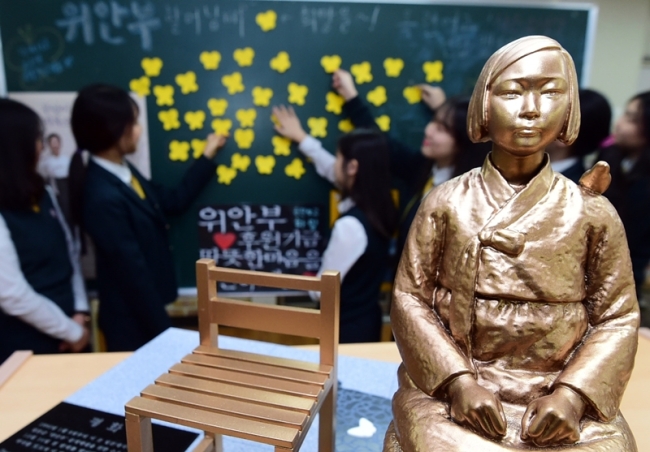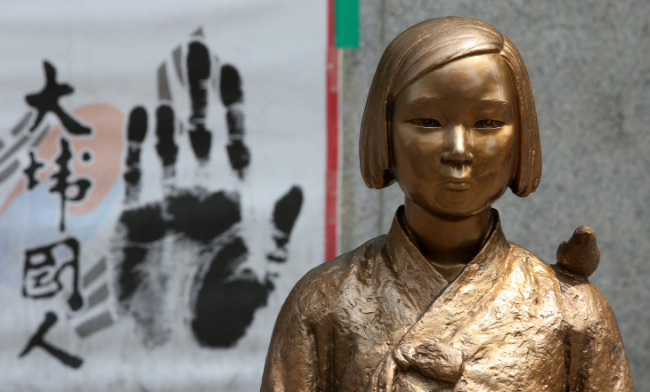[Feature] Sex slave statues multiplying in South Korea
By Korea HeraldPublished : Aug. 1, 2017 - 16:29
Bronze statues of little girls symbolizing wartime sex slaves during Japanese colonial era are multiplying across South Korea, as the historic issue, a long-standing thorn in Seoul-Tokyo relations, remains unsolved more than half a century on.

South Korean activists and supporters try to ensure, with the statues, that Japan’s World War II sexual enslavement of an estimated 200,000 mostly Korean and Chinese “comfort women” is remembered. But the Japanese government sees them as symbols of hatred and a blatant rejection of the “final and irrevocable resolution” reached between the two governments in 2015.
According to civic group Korean Council for the Women Drafted for Military Sexual Slavery by Japan, there are approximately 55 such statues nationwide as of January. Statues have been put in four foreign countries -- the US, Canada, Australia and China.
The first statue, 130 centimeters tall, was erected in front of the Japanese embassy in Seoul in December 2011. It soon became the prototype for many of her sisters that followed. It was unveiled to mark the 1000th “Wednesday Demonstration” -- weekly protests held by surviving victims outside the Japanese Embassy in Jongno, central Seoul, since 1992.
Efforts to honor the victims – many of them have since died – were at first pushed by a few activists, but in recent years they have become more of a grassroots movement.
At Ewha Girls’ High School in central Seoul, an after-school history club is quietly carrying out its goal of distributing 100 miniature comfort women statues to 100 schools in South Korea since the spring of 2015.
The 24-member club arranged for the schools to pay 500,000 won ($438) to Kim Seo-kyung and Kim Woon-sung, the sculptors behind the original comfort women statue. The duo would then make 1-meter replicas of their design for the schools.
According to the club, the money was raised through organized fundraising by a body of students in each school wishing to place the statue in their respective campuses.
When the project started, the members were enthusiastic, but had doubts about meeting their target of 100 orders. This June, the students were busy filing more than 100 requests from schools across the nation.
“The club plans to continue the project until the number of orders reach 239 -- the number of government-registered World War II sexual slavery victims in Korea,” Seong Hwan-cheol, 41-year-old history teacher and club supervisor told The Korea Herald.
“The project is meaningful for these students because they rarely find opportunities to act out their beliefs and this is a healthy means of expression for them.”
“I personally believe Japan should follow the suit of Germany and try to devise a more long-term effort in dealing with issues left behind by the war.”
The comfort women statues, however, have put more strain on the diplomatic relations between Seoul and Tokyo.
In January, Japan recalled its ambassador to South Korea, Yasumasa Nagamine and consul general in Busan, Yasuhiro Morimoto, in protest after a statue was installed outside the Japanese consulate in Busan. Both high-ranking officials returned to Seoul in April, but the unprecedented move had already caused an uproar in South Korea.
“The Japanese government finds this situation extremely regrettable,” Yoshihide Suga, chief cabinet secretary to Abe, said during a press conference in Tokyo after the installation of the Busan statue was announced.
The waves even reached the economic sector as Japan halted talks on a currency swap to stabilize exchange rates, along with other high-level economic talks.
Shin Yool, a social science professor at Myongji University, said that the relationship between the comfort women statues and the diplomatic circumstances surrounding Seoul and Tokyo is a complicated one.
“Japan will continue to side-eye the spread of comfort women statues, but is also reluctant to make a bold threat because of the sensitivity of the current security issues with North Korea,” he told The Korea Herald.
“The statues represent Japan’s reluctance to issue a sincere apology. History won’t just disappear into thin air because they refuse to acknowledge it.”
The comfort women issue is likely to emerge as the top diplomatic issue between the two countries soon, as the new Moon Jae-in administration seeks to undo the 2015 deal, citing “widespread public disapproval.”

In their first meeting last month on the sidelines of the Group of 20 summit in Hamburg, President Moon and Japanese Prime Minister Shinzo Abe expressed their wish to lubricate cross-border exchanges, but refused to let their guards down on the controversial issue.
Abe suggested Seoul to implement the bilateral agreement, where Japan tried to bury the old hatchet by providing a compensation of 1 billion yen ($9 million) to South Korean victims.
Moon responded by saying, “We have to acknowledge the fact that the majority of our people find it emotionally difficult to accept (the deal).”
On Monday, Seoul’s Foreign Ministry formed a task force team to review the 2015 deal and its negotiation process. The government is also planning to designate a national memorial day to remember the victims.
By Jung Min-kyung (mkjung@heraldcorp.com)
-
Articles by Korea Herald




![[Herald Interview] 'Amid aging population, Korea to invite more young professionals from overseas'](http://res.heraldm.com/phpwas/restmb_idxmake.php?idx=644&simg=/content/image/2024/04/24/20240424050844_0.jpg&u=20240424200058)













![[KH Explains] Korean shipbuilding stocks rally: Real growth or bubble?](http://res.heraldm.com/phpwas/restmb_idxmake.php?idx=652&simg=/content/image/2024/04/25/20240425050656_0.jpg&u=)

